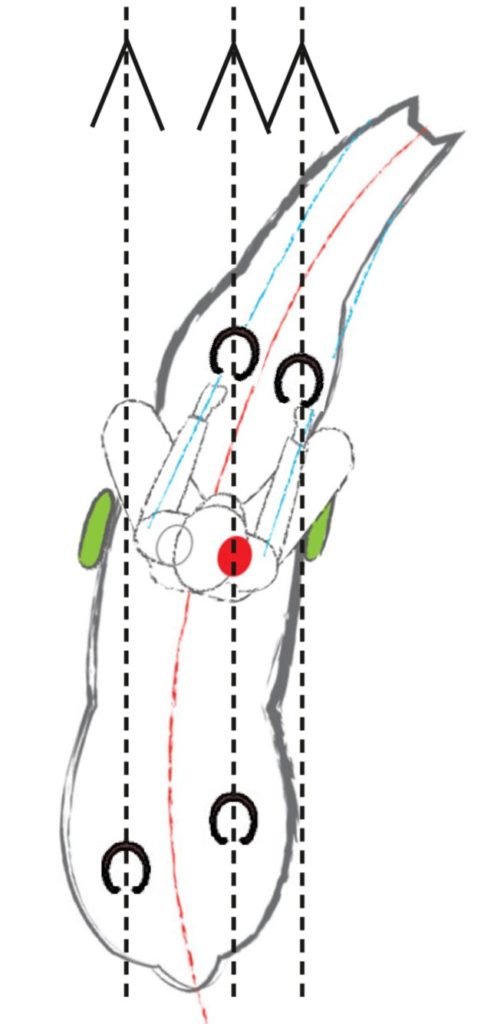06 Jun 14. Shoulder in

Last time, we discussed the reasons for teaching a horse to leg yield (to promote suppleness, loosen its muscles and improve its balance) and how to achieve it. Now we will consider shoulder in, which is typically the next lateral movement taught to a horse, providing similar physical benefits but also requiring the development of stronger muscles to engage the hindquarters – the inside hind leg must stretch and reach under the body – so good preparation for collection exercises.
But first, what is shoulder in? Unlike leg yielding, which requires your horse to move forwards and sideways at the same time with its spine parallel to the track, shoulder in requires it to bend through its ribcage while moving on a straight line. It is a lateral movement in which the horse moves on three tracks, with its shoulders in from the track. Observed head on, you would see the inside front foot on one track, the outside front foot and inside hind foot on a middle track and the outside hind foot on a third track.
Perhaps the easiest way to begin shoulder in is to start as if you are intending to ride a 10 metre circle which will ensure that your horse has the correct bend (about a 30 degree angle to the arena track/wall). Then, keeping that bend and with your weight more on your inside seat bone, you encourage your horse to move forward in a straight line, using your inside leg on the girth, while your outside leg can be slightly back in order to prevent the haunches from falling out. Your body and shoulders should be parallel to your horse’s shoulders, so you need to open your inside shoulder while a long, relaxed inside leg will enable an open and supple hip, allowing your horse to move across. The movement should be controlled by a firm outside rein, while your inside hand should be soft – you will keep the bend by driving with the inside leg into the outside rein, not by pulling your horse’s head round with your inside hand – ideally, you should be able to give with the inside rein and still keep the correct angle. You should aim to maintain the same rhythm – an energetic, forward pace – before, during and after the movement.
There are plenty of pitfalls in learning to ride shoulder in, with many riders using the inside rein to bend the head and neck rather than positioning the shoulders correctly, or bringing their inside leg up as they apply it and consequently shifting their weight to the outside seat bone, allowing the horse’s energy to escape to the outside.
 And while it is fairly easy to tell if your horse is performing leg yield – you can feel the crossing over – it is typically more difficult for a rider to recognise a correct shoulder in so some assistance may be required early on. You can ask your instructor to talk you through the movement or try riding in an arena with mirrors which will provide visual aids to help you develop a better feel – however, the best way to learn is to practise on the EQUICISE because it will enable you to see precisely how you are using your leg aids, while also checking that you are using your weight aids correctly. Although you will not have the feeling of the horse’s body bending around your leg on the EQUICISE, you can learn the correct application of the leg, seat and rein aids and by practising the movements repeatedly you will ensure that the skills you learn are transferable to a real horse. There are three leg sensors on either side of the simulator’s torso; to perform shoulder in you will need to apply your ‘inside’ leg on the first sensor and your ‘outside’ leg on the second sensor, while maintaining a light contact on the ‘inside’ rein and sitting on your ‘inside’ seat bone. You can practise holding your leg consistently on the sensors or use on/off movements as you would on a real horse. Time spent on the EQUICISE will enable you to train your legs to be in the correct position and to practise using different amounts of pressure, thereby building up strength in your legs.
And while it is fairly easy to tell if your horse is performing leg yield – you can feel the crossing over – it is typically more difficult for a rider to recognise a correct shoulder in so some assistance may be required early on. You can ask your instructor to talk you through the movement or try riding in an arena with mirrors which will provide visual aids to help you develop a better feel – however, the best way to learn is to practise on the EQUICISE because it will enable you to see precisely how you are using your leg aids, while also checking that you are using your weight aids correctly. Although you will not have the feeling of the horse’s body bending around your leg on the EQUICISE, you can learn the correct application of the leg, seat and rein aids and by practising the movements repeatedly you will ensure that the skills you learn are transferable to a real horse. There are three leg sensors on either side of the simulator’s torso; to perform shoulder in you will need to apply your ‘inside’ leg on the first sensor and your ‘outside’ leg on the second sensor, while maintaining a light contact on the ‘inside’ rein and sitting on your ‘inside’ seat bone. You can practise holding your leg consistently on the sensors or use on/off movements as you would on a real horse. Time spent on the EQUICISE will enable you to train your legs to be in the correct position and to practise using different amounts of pressure, thereby building up strength in your legs.
You will also be able to use the mirrors that surround the EQUICISE (on either side, at the front and to the rear) to check that you are maintaining a correct upper body position while attempting shoulder in. When you are on a real horse, you will find that you are able to perform shoulder in more instinctively instead of having to focus so much on the aids you need to apply. For the more accomplished rider, time spent on the EQUICISE provides the opportunity to focus on refining your technique without having to train a horse at the same time.
Book a LESSON on the EQUICISE and see how it can help you to improve riding shoulder in.
PRACTISE THIS ON THE EQUICISE SIMULATOR

Starting on "Instruction ride" screen, begin walking and put your weight to the left seat bone. Then use only your left leg on the first leg sensor, followed by right leg on second leg sensor, and then turn your shoulders slightly to the left, bringing your left hand with it and bending the horse to the left. Keep an eye on the right top corner of the screen to make sure you are performing the shoulder in. Repeat to the other side. To make it harder, do the same in trot and canter. Even harder? Go to the instruction ride screen and do the same keeping the horse on the outside track inside the arena.
PRACTISE THIS ON THE EQUICISE SIMULATOR

Starting on "Instruction ride" screen, begin walking and put your weight to the left seat bone. Then use only your left leg on the first leg sensor, followed by right leg on second leg sensor, and then turn your shoulders slightly to the left, bringing your left hand with it and bending the horse to the left. Keep an eye on the right top corner of the screen to make sure you are performing the shoulder in. Repeat to the other side. To make it harder, do the same in trot and canter. Even harder? Go to the instruction ride screen and do the same keeping the horse on the outside track inside the arena.
BOOK NOW




